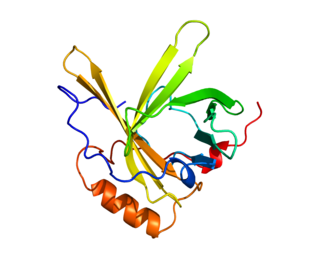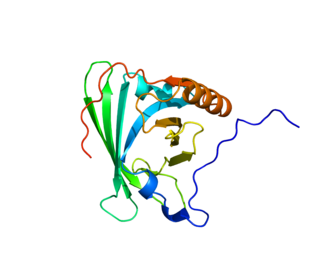Related Research Articles

Apolipoproteins are proteins that bind lipids to form lipoproteins. They transport lipids in blood, cerebrospinal fluid and lymph.

Trypanosoma brucei is a species of parasitic kinetoplastid belonging to the genus Trypanosoma. This parasite is the cause of vector-borne diseases of vertebrate animals, including humans, carried by species of tsetse fly in sub-Saharan Africa. In humans T. brucei causes African trypanosomiasis, or sleeping sickness. In animals it causes animal trypanosomiasis, also called nagana in cattle and horses. T. brucei has traditionally been grouped into three subspecies: T. b. brucei, T. b. gambiense and T. b. rhodesiense. The first is a parasite of non-human vertebrates, while the latter two are known to be parasites of humans. Only rarely can the T. b. brucei infect a human.

Apolipoprotein E (APOE) is a protein involved in the metabolism of fats in the body of mammals. A subtype is implicated in Alzheimer's disease and cardiovascular disease.

Apolipoprotein B (ApoB) is a protein that in humans is encoded by the APOB gene.

Apolipoprotein C-I is a protein component of lipoproteins that in humans is encoded by the APOC1 gene.
The liver X receptor (LXR) is a member of the nuclear receptor family of transcription factors and is closely related to nuclear receptors such as the PPARs, FXR and RXR. Liver X receptors (LXRs) are important regulators of cholesterol, fatty acid, and glucose homeostasis. LXRs were earlier classified as orphan nuclear receptors, however, upon discovery of endogenous oxysterols as ligands they were subsequently deorphanized.

Apolipoprotein A1 is a protein that in humans is encoded by the APOA1 gene. As the major component of HDL particles, it has a specific role in lipid metabolism. The text in a 2014 report suggested that APOA1 mRNA is regulated by endogenously expressed antisense RNA.

Apolipoprotein C-III also known as apo-CIII, and apolipoprotein C3, is a protein that in humans is encoded by the APOC3 gene. Apo-CIII is secreted by the liver as well as the small intestine, and is found on triglyceride-rich lipoproteins such as chylomicrons, very low density lipoprotein (VLDL), and remnant cholesterol.

Apolipoprotein C-IV, also known as apolipoprotein C4, is a protein that in humans is encoded by the APOC4 gene.

Apolipoprotein D is a protein that in humans is encoded by the APOD gene. Unlike other lipoproteins, which are mainly produced in the liver, apolipoprotein D is mainly produced in the brain and testes. It is a 29 kDa glycoprotein discovered in 1963 as a component of the High Density Lipoprotein (HDL) fraction of human plasma. It is the major component of human mammary cyst fluid. The human gene encoding it was cloned in 1986 and the deduced protein sequence revealed that ApoD is a member of the lipocalin family, small hydrophobic molecule transporters. ApoD is 169 amino acids long, including a secretion peptide signal of 20 amino acids. It contains two glycosylation sites and the molecular weight of the mature protein varies from 20 to 32 kDa.

Apolipoprotein A-V is a protein that in humans is encoded by the APOA5 gene on chromosome 11. It is significantly expressed in liver. The protein encoded by this gene is an apolipoprotein and an important determinant of plasma triglyceride levels, a major risk factor for coronary artery disease. It is a component of several lipoprotein fractions including VLDL, HDL, chylomicrons. It is believed that apoA-V affects lipoprotein metabolism by interacting with LDL-R gene family receptors. Considering its association with lipoprotein levels, APOA5 is implicated in metabolic syndrome. The APOA5 gene also contains one of 27 SNPs associated with increased risk of coronary artery disease.

Apolipoprotein A-II is a protein that in humans is encoded by the APOA2 gene.

Apolipoprotein A-IV is plasma protein that is the product of the human gene APOA4.

Trace amine associated receptor 6, also known as TAAR6, is a protein which in humans is encoded by the TAAR6 gene.

Apolipoprotein B mRNA editing enzyme, catalytic polypeptide 1 also known as C->U-editing enzyme APOBEC-1 is a protein that in humans is encoded by the APOBEC1 gene.

Apolipoprotein M is a protein that in humans is encoded by the APOM gene.

Apolipoprotein L1 is a protein that in humans is encoded by the APOL1 gene. Two transcript variants encoding two different isoforms have been found for this gene.

Synapsin-3 is a protein that in humans is encoded by the SYN3 gene.

Protein DGCR6 is a protein that in humans is encoded by the DGCR6 gene.

Apolipoprotein L2 is a protein that in humans is encoded by the APOL2 gene.
References
- ↑ Arai H, Mimmack ML, Ryan M, Baba H, Navarro-ruiz J, Iritani S, Faull RL, Mckenna PJ, Jones PB, Starkey M, Emson PC, Bahn S (2002). "Gene expression analysis in schizophrenia: reproducible up-regulation of several members of the apolipoprotein L family located in a high-susceptibility locus for schizophrenia on chromosome 22". Proc. Natl. Acad. Sci. U.S.A. 99 (7): 4680–4685. Bibcode:2002PNAS...99.4680M. doi: 10.1073/pnas.032069099 . PMC 123707 . PMID 11930015.